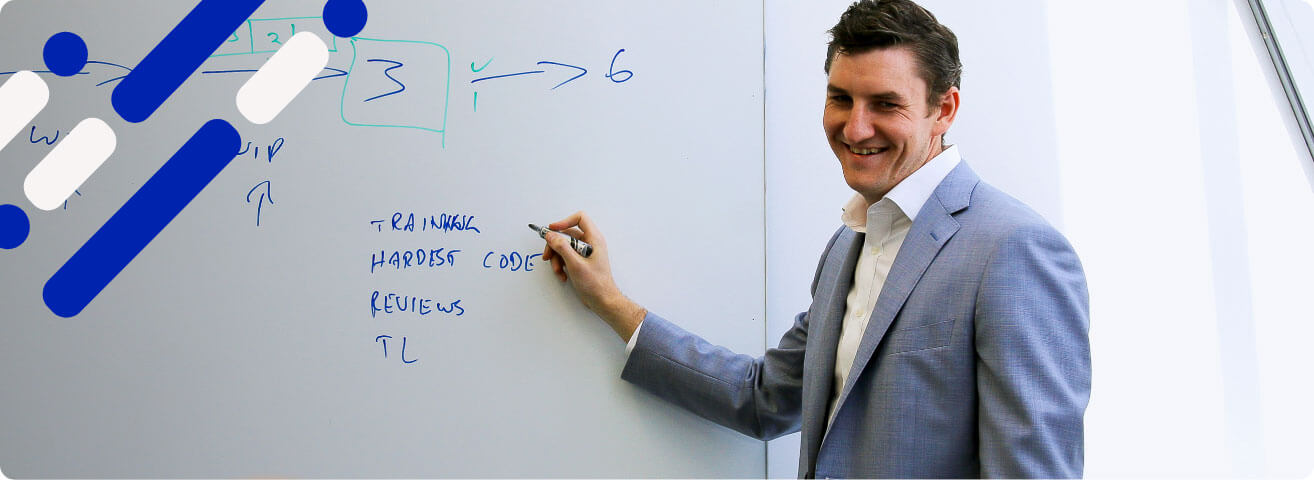Iterate 30% faster. Scale 30% faster. Kickstart your software development now.
- Proven
- Effective
- Scalable
Peter Cronin has structured this workshop in two distinct parts.
Part 1.
In Part One, Peter dissects the fundamental flaws of SCRUM and Sprints. In doing so, he demonstrates how their underlying assumptions and operating rules hold back Agile — and limit its potential to help teams produce high-quality features more quickly.
Part 2.
In Part Two, Peter introduces an alternative — Pace. He’ll prove that only Pace fully leverages the power of Agile. He’ll also outline Pace’s underlying framework: 3 new principles and 12 behaviours that — if adopted — will let you and your team push new features to users 30% more quickly.

Part 1.
Sprints and SCRUM are crippling dev pipelines
Does your backlog feel like a constant stream of bugfixes? Do your people persistently have trouble hitting sprint targets? Is development regularly behind schedule?
Part One will expose an uncomfortable truth: as most commonly used, Agile is insufficiently responsive for modern software pipelines.
The rigid implementation of Sprints and SCRUM is responsible.
Peter will demonstrate that striving for perfect across-the-board utilisation only creates inefficiency. That arbitrary production deadlines inevitably destroy code quality due to Student Syndrome. And that padding individual task estimates is actually the leading cause of blowouts.
Worse, Peter will show that Dev teams and managers have learnt to live with these endemic problems rather than solve them.

Part 2.
Pace: a new framework to make Agile agile
Part Two will introduce a new, breakthrough framework for extracting the most from Agile: Pace.
Peter will show that this framework of 3 principles and 12 behavioural rules enables you to deploy features to users 30% faster — with no decrease in quality.
These 3 principles are, conceptually, extraordinarily simple: manage your bottleneck; manage the variation; manage the flow.
Peter will demonstrate that applying four new behavioural rules to each of these principles is sufficient to dramatically raise throughput and eliminate the schedule “recovery” mentality that is a leading cause of coding mistakes.
He’ll prove that this is in fact critical: do it right and you will succeed, do it wrong and you will fail.
Finally, Peter will show that although Pace is a vast deviation from the typical execution of Agile (SCRUM) it perfectly fits its overarching paradigm.
Sprints versus Pace
| Sprints/SCRUM | Pace |
|---|---|
| Due dates | Zone-based |
| Longer commitments | Smaller chunks |
| Inappropriate timeboxes | Estimation-based job iterations |
| Efficiency focus | Bottleneck planned |
| Capacity planned | Team planned |
| Start/stop | Continuous flow |
| Variation mis-management | Buffers |
| Intuition-based progress management | Two system response |
What will my plan look like?
The objective is for each attending executive, over the course of the day, to fashion a simple (but detailed) plan that would implement The WiseTech Way in their organisation.
Obviously, the finer points of each plan will vary depending on your current size, marketplace maturity and growth goals. But, in a nutshell this plan will consist of:
- Identification of the fundamental constraint of your production teams and maximum output of that constraint (the system can output no more than this constraint).
- A system to use this constraint as a strategic source of management intelligence to manage and schedule the production and release of work (so the constraint always has work).
- A toolset to accelerate management responsiveness and strategy formulation to repeatedly come up with killer features that customers don’t even know they want yet (but will fall over to embrace once they see them).
- A management framework that willingly embraces the risk of error but is able to manage risk so that errors are small and survivable, not large and fatal.
You will leave this workshop with a practical understanding of Pace and all the necessary steps you will need to take to actualise it yourself.
Developing at Pace Workshop Agenda

Agile insufficiency

Does Pace deliver?

A new Agile framework: Pace

Discover the need for speed
Who should attend
If you’re tired of missed deadlines, constant firefighting, and a development pipeline increasingly overgrown with bug fixing—then there’s a very good chance that this workshop will be a worthy investment of time and money.
Because the implications of this workshop have wide-ranging implications for many parts of the organisation, it is advisable you bring along with you a couple of key people from your business, so you can have more valuable application discussions with others from your team.